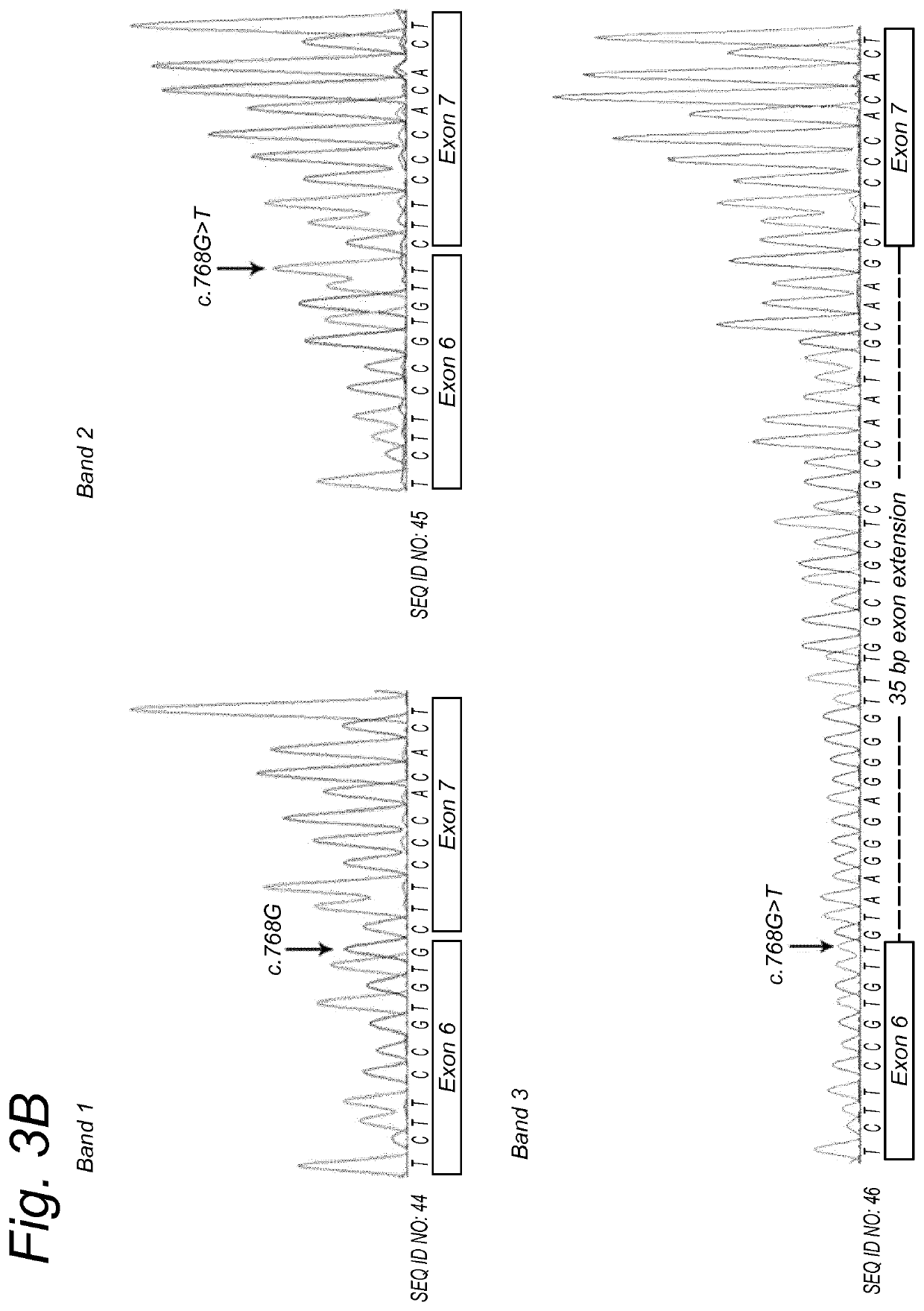Antisense Oligonucleotides Rescue Aberrant Splicing of ABCA4
an antisense oligonucleotide and aberrant splicing technology, applied in the field of immunology, can solve the problems of premature termination of abca4 protein synthesis
- Summary
- Abstract
- Description
- Claims
- Application Information
AI Technical Summary
Benefits of technology
Problems solved by technology
Method used
Image
Examples
example 1
[0130]First, in the Materials and Methods section, the experimental details are described, whereas the results are described and illustrated in the Results section further below.
[0131]Materials and Methods
[0132]AON Design and Testing
[0133]To design the AONs, a smaller region of interest of 257 bp was selected (SEQ ID NO: 5). Subsequently, oligonucleotides of ˜20 nucleotides in length were designed. All oligonucleotides were subjected to in silico RNA structure prediction. Eight AONs that showed differences in predicted structure and / or had the best accessibility were designed and ordered in different chemistries (see Table 2 and FIG. 2).
TABLE 2AON'sSEQIDChemicalAON#NO:AON sequence (5′->3′)modificationsAON16ACCCCAGGAAUCACCUUGCA2′O-methyl (2′-OMe)AON210GCUCUGCUACCCCAGGAAUC2′-OMeAON314CAAUUGGCGAGCAGCCAAAunmodifiedAON418AUCACCUUGCAAUUGGCGAGunmodifiedAON522GAGCAGCCAAACCCCUCCCUunmodifiedAON626UUGGCGAGCAGCCAAACCCCunmodifiedAON730CUUGCAAUUGGCGAGCAGCCunmodifiedAON834GGAAUCACCUUGCAAUUGGCG2′-O...
example 2
[0140]Here, we report on expansion of example 1, using more AONs (different in terms of sequence as well as chemistry) and employing multiple cellular systems (HEK293T cells and patient-derived fibroblasts.
[0141]Materials and Methods
[0142]AON Design
[0143]To design the AONs, a small ABCA4 region of 235 bp was selected; ABCA4 c.669−c.768+135. Subsequently, a total of 26 AONs (each 21 nucleotides in length) were designed and labelled AON10 to AON35. AON10 to AON34 were designed with 2′-O-Methyl (2′-OMe) chemical modification and AON35 was designed with 2′O-methoxyethyl (2′-O-MOE) chemistry. Following the first results, five more AONs with 2′-O-MOE chemistry were ordered, labelled AON36-AON40 and corresponding to the sequences of AON14, -15, -16, -19 and 23, respectively. For each chemistry, a sense oligonucleotide was ordered, harboring the sequences complementary to AON22 and -35, respectively. All AONs (and SONs) are listed in Table 3. All listed AON's have a phosphorothioate backbon...
PUM
| Property | Measurement | Unit |
|---|---|---|
| Mass | aaaaa | aaaaa |
| Mass | aaaaa | aaaaa |
| Mass | aaaaa | aaaaa |
Abstract
Description
Claims
Application Information
 Login to View More
Login to View More - R&D Engineer
- R&D Manager
- IP Professional
- Industry Leading Data Capabilities
- Powerful AI technology
- Patent DNA Extraction
Browse by: Latest US Patents, China's latest patents, Technical Efficacy Thesaurus, Application Domain, Technology Topic, Popular Technical Reports.
© 2024 PatSnap. All rights reserved.Legal|Privacy policy|Modern Slavery Act Transparency Statement|Sitemap|About US| Contact US: help@patsnap.com










